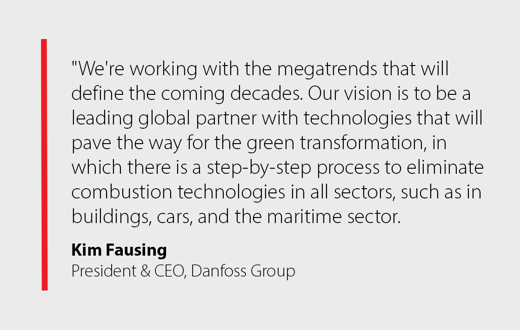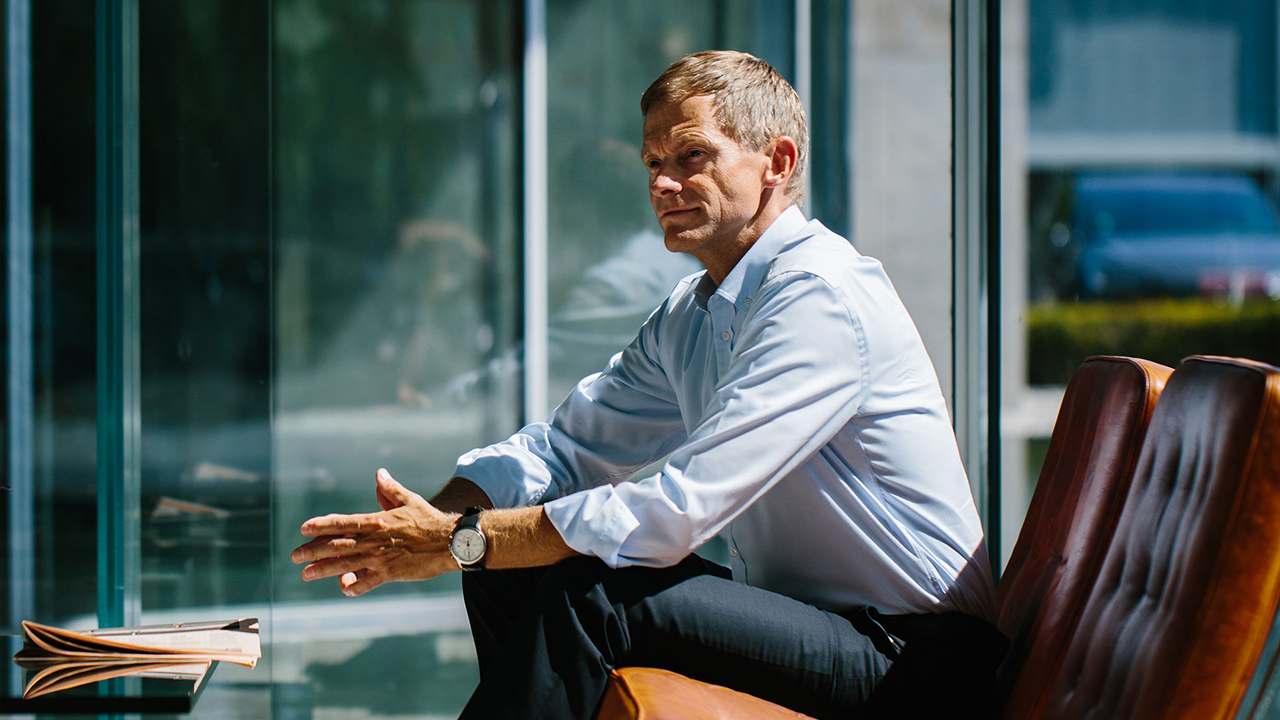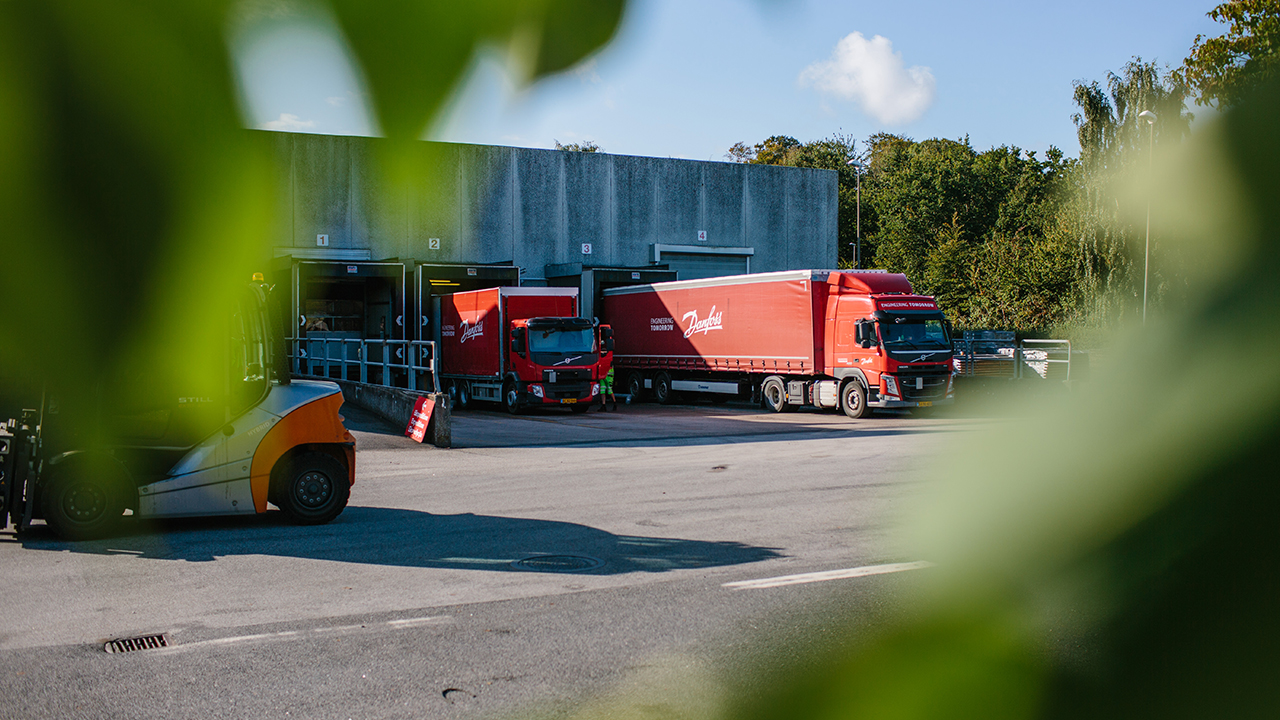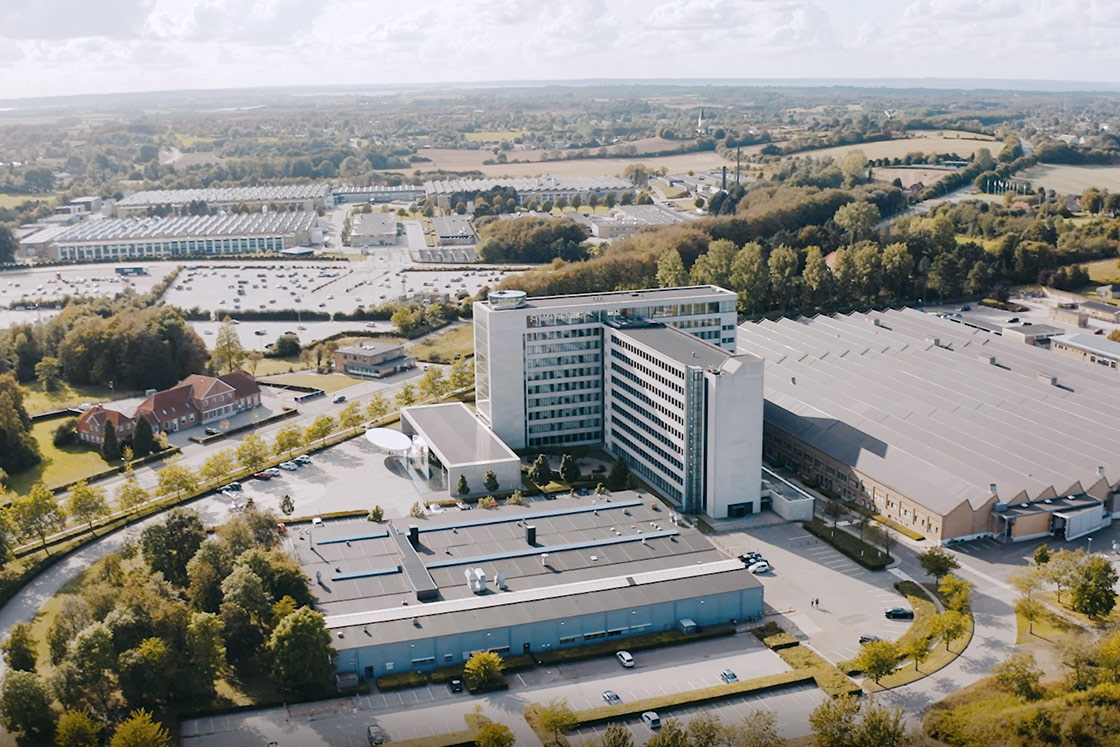The tone is set by chance. The final stretch to Nordborg on Als takes place in an electric taxi that winds its way through the light green spring landscape, which has been the focal point of the family-owned company since engineer Mads Clausen founded it on his parents’ farm in 1933.

The founder’s farm is still there, and the flag is raised daily in the courtyard. However, in the past 89 years, production halls in the surrounding fields have sprung up totaling just over 250,000 square meters. Meanwhile the company has grown into a global player with sales close to USD 10 billion this year, 40,000 employees worldwide, and 95 factories in 20 countries.
Danfoss' production legacy is still deeply integrated in the company, with cooling and heating valves still amongst the 100,000 components sold by Danfoss. Danfoss is investing significantly in electrification and improvements in energy efficiency in the battle against climate change.
"We're working with the megatrends that will define the coming decades. Our vision is to be a leading global partner with technologies that will pave the way for the green transformation, in which there is a step-by-step process to eliminate combustion technologies in all sectors, such as in buildings, cars, and the maritime sector," says CEO Kim Fausing.

Green energy is not enough
It is an ambitious vision, but one where the bird is in the hand – not the bush. All the necessary technologies are in place, as Fausing points out, describing how the company from the Southern part of Jutland is concrete proof that ambitious climate targets can be delivered on.
“We have created Denmark’s largest showroom here,” he says, explaining how the 250,00 square meters, including production halls, will be carbon neutral in buildings and processes this year thanks to energy efficiency improvements, heat pumps, a district heating plant fired with straw from local farmers, and the reuse of surplus heat. The remaining energy consumption is supplied by a solar farm next to the factory and wind energy from Horns Rev offshore wind farm.
In addition, the foundation is being laid for a brand new, energy-efficient Coop supermarket, where Nordborg residents and Danfoss employees will soon be able to do their shopping. The supermarket will in itself will be a showcase for the retail trade, and a place where Danfoss can present its solutions in practice.
"Seeing is believing and for us, it’s crucial to show that the technology is in place, and it is a short payback time to reap the benefits. We have heard enough talk, and now it is crucial to act on energy efficiency measures if we are to achieve the overall climate goals of the Paris Agreement by 2030," he says.
"You have to understand – whether you like it or not – that energy efficiency is necessary. Of course, we can build a lot of green energy, but it cannot stand alone if we are going to achieve the climate goals. And it would also not make financial sense to focus solely on green energy, as this would make the transition twice as expensive. We won’t be able to reach the 2030 targets of the Paris Agreement if we do not start prioritizing energy efficiency. It’s that simple. Energy efficiency is imperative to cut CO2 emissions globally.”
At the beginning of June, Danfoss was able to let all stakeholders see this for themselves when Sønderborg served as host city for the International Energy Agency’s yearly conference on energy efficiency. It is a conference that brings together a total of 300 ministers, officials, organizations, and companies from 30 countries.
"It is the best and most credible conference in this area. For us, it is crucial to make sure that energy efficiency is higher up the agenda, and this conference is a great way to get the message out across the board," says Fausing.

Fausing does not hide the fact that it is a struggle to get energy savings and efficiency improvements to the top of the political agenda. As a result, Fausing himself is actively pursuing opportunities to draw attention to energy efficiency measures. Danfoss was an active campaigner for energy efficiency at the COP26 climate conference in Glasgow in November 2021, and ran advertisements in the Financial Times. Fausing was pleased with the result, and energy efficiency was written into the COP26 declaration for the first time ever.
In April, Danish Prime Minister Mette Frederiksen visited Fausing to see Danfoss’ solutions. Fausing thereby hopes to open politicians’ eyes to the potential of energy efficiency.
The Danfoss chief calls for more clear goals for how energy efficiency will contribute to the green transition and the overall climate goals.
"There is progress, but there is still no clear idea of how energy efficiency improvement should contribute. We need greater political involvement at many levels, from mayors to the EU," says Fausing.

District heating can replace Russian gas
However, time is on the side of Danfoss' agenda. Since February 24, the interest in the green transition has become more relevant due to the tragic backdrop of Russia’s invasion of Ukraine. Europe has now decided to become independent of Russian oil and gas as soon as possible, and alternative energy and energy savings will be a part of the solution.
"Better use of energy and supply security are completely intertwined because, for example, if Europe succeeded in switching to the same proportion of district heating as we have in Denmark, then we would be able to completely eliminate the need for Russian gas. Rising energy prices are yet another motivating factor, as they make energy efficiency even more financially attractive," Fausing explains.
Here, cooperation between governments and industry is crucial to resolving the current limitations together.
"It’s hard work. But the good news is that it is technologically possible. This is a long haul in which the goals to be achieved are specified step-by-step," says Fausing.

Measurability
According to the Danfoss CEO, the will to have very specific goals and, not least, sub-goals is crucial. Transparency is key because it makes progress visible and keeps all parties committed to action. He refers to the work of the "Climate Partnership for Manufacturing Industry”, where as chairman he represented more than 12,000 companies.
The dynamic was great here, but there was a lack of specific measurement methods. That is also why Fausing, and the Confederation of Danish Industry and the Danish Industry Foundation, are the driving forces behind the "Climate-Ready Production Company" project, which provides a tool for measuring the impact on the climate.
"In Denmark, we are good at having visions. But there is also a need for a culture of action where there are sub-goals to be met along the way. Otherwise, it becomes a case of flying blind, and we'll quickly end up with nice speeches and no action. If you don't measure where you are in 2026 or 2028, how do you know if you'll achieve the overall goal by 2030?" asks Fausing rhetorically.
Danfoss is in the process of introducing the internationally recognized Science-Based Target, a measurement system that the country’s 12,000 production companies are now also offered in the "Climate-Ready Production Company" project.

Chain reaction in climate requirements
Danfoss’ own climate cure is not just a desire to be more climate-friendly and optimize energy consumption for the benefit of the bottom line. The requirement also comes from outside, with customers’ requirements for documentation of the products’ climate footprint, which triggers a chain reaction where Danfoss’ subcontractors must also be transparent.
Danfoss now works with the largest suppliers of raw materials such as steel and aluminum. And smaller suppliers will also join later if they want to keep Danfoss as a customer.
Fausing elaborates: "We have some customers who are very clear about what they demand from us. We are therefore in the process of adapting, which is why we are doing a lot to include our suppliers. And it is clear that, in the long run, it will naturally be a problem for a supplier if they don't want to go in that direction."
Danfoss’ goal is to provide all products with a certificate showing the total carbon footprint, and that requires that sub-suppliers can also document their climate accounts.
"This development is not only important, but it’s the right thing to do. It also gives all production companies an opportunity to differentiate ourselves in the future for the benefit of competitiveness. Because why would a customer otherwise prefer a company like Danfoss if you can find a supplier elsewhere in the world that is perhaps cheaper?" Fausing asks.
In the future, the Danfoss CEO sees significant perspectives. He has now been CEO for five years during which business has doubled and the focus on becoming a supplier of climate solutions has expanded even more.
The company’s own climate ambitions have also spiraled. With the milestone of a carbon-neutral production area in Als reached several years before the original plan, the goal now is to achieve CO2-neutrality in factories in 2030.

Growth despite of turbulence
Fausing also believes in business growth in the coming years. This may not double again in five years, but it will move in the right direction – uncertain times or not.
"There is a lot of turbulence right now with war in Europe and hyperinflation, while interest rates, prices and costs are rising. However, the underlying trends are the right ones in the longer term. The entire energy sector is moving in the right direction, and we are investing a lot in development and acquisitions. Therefore, you'll see a stronger and more well-positioned Danfoss in five years’ time, when we stand well positioned on the track we have laid," concludes Fausing in the DI Business interview.

Key facts about Danfoss:
- Founded in 1933 by engineer Mads Clausen, who started producing valves for refrigeration plants.
- Currently manufactures a wide range of products within energy-efficient technologies.
- Headquarters in Nordborg, Denmark, with a 250,000 square meter site consisting of factories, development spaces and offices.
- Has a total of 95 factories in 20 countries and customers in more than 100 countries.
- Expects a turnover of about than euro 10 billion in 2022.
- 40,000 employees in 2022
- Kim Fausing has been with Danfoss for 15 years and CEO since July 2017.
- Kim Fausing is chairman of the government’s "Climate Partnership for Production Companies".


